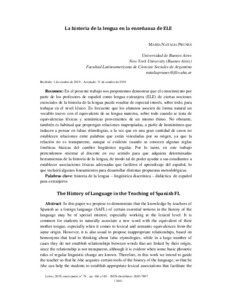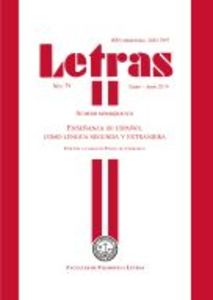Por favor, use este identificador para citar o enlazar este ítem:
https://repositorio.uca.edu.ar/handle/123456789/9618| Título: | La historia de la lengua en la enseñanza de ELE The history of language in the teaching of spanish FL |
Autor: | Prunes, María Natalia | Palabras clave: | ENSEÑANZA DE UNA SEGUNDA LENGUA; LINGÜISTICA; HISTORIA DE LA LENGUA | Fecha de publicación: | 2019 | Editorial: | Universidad Católica Argentina. Facultad de Filosofía y Letras | Cita: | Prunes, M. N. La historia de la lengua en la enseñanza de ELE. [en línea]. Letras. 2019, 79. Disponible en: https://repositorio.uca.edu.ar/handle/123456789/9618 | Resumen: | Resumen: En el presente trabajo nos proponemos demostrar que el conocimiento por
parte de los profesores de español como lengua extranjera (ELE) de ciertas nociones
esenciales de la historia de la lengua puede resultar de especial interés, sobre todo, para
trabajar en el nivel léxico. Es frecuente que los alumnos asocien de forma natural un
vocablo nuevo con el equivalente de su lengua materna, sobre todo cuando se trata de
equivalencias léxicas y semánticas provenientes de un mismo étimo. No obstante,
también es habitual que propongan relaciones inapropiadas, a partir de homónimos que
inducen a pensar en falsas etimologías, a la vez que en una gran cantidad de casos no
establecen relaciones entre palabras que están vinculadas por su origen, ya que la
relación no es transparente, aunque sí evidente cuando se conocen algunas reglas
fonéticas básicas del cambio lingüístico regular. Por lo tanto, en este trabajo
pretendemos orientar al docente en ese sentido para que adquiera determinadas
herramientas de la historia de la lengua, de modo tal de poder ayudar a sus estudiantes a
establecer asociaciones léxicas adecuadas que faciliten el aprendizaje del español, lo
que incluirá algunos lineamientos para desarrollar distintas propuestas metodológicas. Abstract: In this paper we propose to demonstrate that the knowledge by teachers of Spanish as a foreign language (SAFL) of certain essential notions in the history of the language may be of special interest, especially working at the lexical level. It is common for students to naturally associate a new word with the equivalent of their mother tongue, especially when it comes to lexical and semantic equivalences from the same origin. However, it is also usual to propose inappropriate relationships, based on homonyms that lead to thinking about false etymologies, while in a large number of cases they do not establish relationships between words that are linked by their origin, since the relationship is not transparent, although it is evident when some basic phonetic rules of regular linguistic change are known. Therefore, in this work we intend to guide the teacher so that he /she acquires certain tools of the history of the language, so that he /she can help the students to establish appropriate lexical associations that facilitate the learning of Spanish, which will include some guidelines to develop different methodological proposals. |
URI: | https://repositorio.uca.edu.ar/handle/123456789/9618 | ISSN: | 2683-7897 (on line) | Disciplina: | LENGUA | Derechos: | Acceso abierto | Fuente: | Letras Nº 79, 2019 |
| Aparece en las colecciones: | LETRAS - 2019 nro. 79 |
Ficheros en este ítem:
| Fichero | Descripción | Tamaño | Formato | |
|---|---|---|---|---|
| historia-lengua-ensenanza-ele.pdf | 197,25 kB | Adobe PDF |  Visualizar/Abrir | |
| letras79.jpg | 4,33 kB | JPEG |  Visualizar/Abrir |
Visualizaciones de página(s)
235
comprobado en 30-abr-2024
Descarga(s)
849
comprobado en 30-abr-2024
Google ScholarTM
Ver en Google Scholar
Este ítem está sujeto a una Licencia Creative Commons

